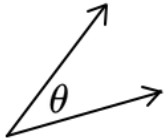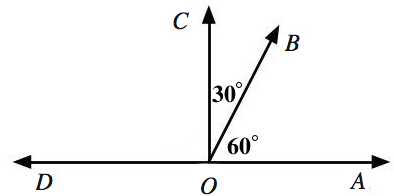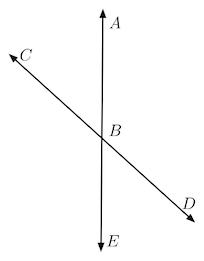Angles

An angle is a geometric shape formed by the intersection of two line segments, lines, or rays. Angles are a measure of rotational distance as contrasted with linear distance. An angle can also be thought of as a fraction of a circle. The angle between the two line segments is the distance (measured in degrees or radians) that one segment must be rotated around the intersecting point so that the two segments overlap. Angles are important to defining and studying polygons such as triangles and quadrilaterals. They are used in a variety of disciplines, ranging from animation to carpentry to physics.
Contents
Types of Angles
Angles can be classified into five groups, based on their measure in degrees.

- Acute: angles with measure
- Right: angles with measure
- Obtuse: angles with measure and
- Straight: angles with measure
- Reflex: angles with measure and
If , what type of angle is it?
Since , angle ABC is an obtuse angle.
If angle is acute, which of the following is a possible measure of it?
The answer is An acute angle is between and . The only value that lies within this range is
For the graphic above, which of the angles below is an acute angle?
The answer is is a straight angle. Both and are obtuse. Only is less than so it is the only acute angle in the list.
If is obtuse and , what type of angle is
Since is obtuse, it follows that . Similarly, if , then . Therefore, is an acute angle.
If is acute and is acute, and the points and lie on opposite sides of the line , what is known about the angle
and are acute, which means that and . Since points and lie on opposite sides of the line , we have .Therefore: and the answer is
Complementary and Supplementary Angles
Complementary angles are angles that add together to make a right angle. That is, and are complementary if
Supplementary angles are angles that add together to make a straight line. That is, and are supplementary if

In the image above, and are complementary, and and are supplementary.
Angles and are complementary. What is the measure of angle
Since the two angles are complementary, their sum is . Therefore,
Three points lie on a straight line in that order. What can we say about angles and where does not lie on the line?
Since the points lie on a straight line, , these angles are supplementary.
If , which of the following is complementary to it?
The complementary angles would add together to give , so we have implying that the answer is
What is the sum of the complementary angles?
If and are supplementary, and , what are the measures of angles and
Given that and , solve the system of equations. Adding the two yields , or . Finally, .
If angles and are complementary, and angles and are supplementary, what do we know about angles and
We have and .Therefore, .
The magnitude of the complementary of an angle is equal to the square of the angle's magnitude.
Find the angle in degrees.
Vertical Angles
The two opposite angles formed by a pair of intersecting lines are called vertical angles. These angles have equal measures.

In the diagram above and are vertical angles and are therefore equal.
If lines and intersect at , which angle is vertically opposite
The angle that is vertically opposite will be which is also
In the following diagram, which pair of angles are vertically opposite?
 Working through these pairs, we see that the only pair of opposite angles are and . Therefore, the answer is .
Working through these pairs, we see that the only pair of opposite angles are and . Therefore, the answer is .Note: Another pair of vertical angles are and .
Given that and are straight lines intersecting each other, if , what is the measure of

and are vertical angles, and thus .
If and are vertically opposite angles and , what is the measure of
Since they are vertically opposite angles, . Therefore, , or .
In the following diagram, given that and , what is the measure of
 Since and are vertical angles, they are equal. Thus, . But . Thus . Therefore, .
Since and are vertical angles, they are equal. Thus, . But . Thus . Therefore, .

In the figure, with what is the measure of (in degrees)?
Clarification: are all straight lines.

Three line segments intersect at a single point in the diagram at right.
Find the sum of the angles in degrees.
Angle Chasing
It is possible to find a missing angle measure if the values of other angles in the question are known. Start by drawing a diagram and labeling each known angle.
- Angles at a point sum to .
- Angles on a line sum to .
- Angles in a triangle sum to .
- Vertical angles are equal.
and are 3 consecutive points on a line. If , what is the measure of
Angles on a line sum to , so we have . Hence, this gives us .
Lines and intersect at . If , what is the measure of angle
Since and are angles on the line , they sum up to . Thus
In the following image, if and , what is the measure of angle
image
We have .
 Find the value of
Find the value of
Note: is a straight line.
 In the figure, what is the measure of (in degrees)?
In the figure, what is the measure of (in degrees)?
Remembering that the sum of all the interior angles of a triangle is is useful in solving the following examples:
In triangle , if and , what is the measure of angle
 Since angles in a triangle sum to ,
Since angles in a triangle sum to ,

Find the sum (in degrees) of the four colored angles in the diagram.

In the figure, four line segments intersect at a single point.
Find the value (in degrees) of the angle sum
Note: , , and .
